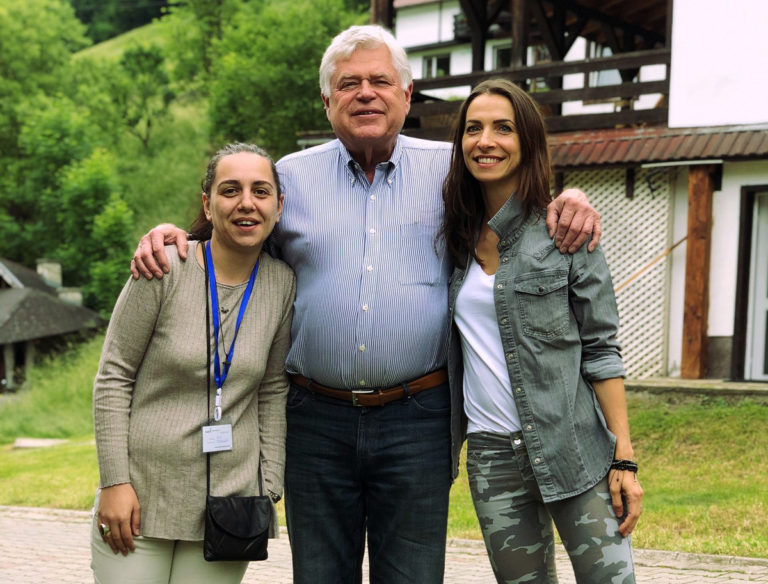California- They’re Not Dreamin, They’re Doing! Getting Serious About Processing and Working Memory
by Robert J. Doman Jr.
 I recently returned from our Chapter in Southern California with renewed faith that our families there are really “getting” the importance of working memory/sequential processing. More importantly, they understand that they can really change it—dramatically! But before I tell you their specific stories, let’s look at the key they discovered to success—success at processing, at program, at learning anything: INTENSITY.
I recently returned from our Chapter in Southern California with renewed faith that our families there are really “getting” the importance of working memory/sequential processing. More importantly, they understand that they can really change it—dramatically! But before I tell you their specific stories, let’s look at the key they discovered to success—success at processing, at program, at learning anything: INTENSITY.
A number of years ago I had a group of teenage girls in the Chapter who all knew each other and were in a competition to out-do each other with their processing skills. This group, who had come to us with issues ranging from brain injury to learning disability and ADD, had all been on program for a year or more before they started their competition. For the most part they were home-schooled, although they took an occasional class at their local schools, and on a whole they were doing well with their programs and making good gains. But once they began competing, their processing scores began to soar, and all of their academic and attention issues began to evaporate.
How well did they do? Most of their digit spans were in the 12 to 18 range, with an occasional spike hitting 19 and 20; and that was without chunking or chaining. I remember one of the moms calling me during this period to tell me her daughter had taught herself calculus that day—not that year or month, but that day! The girls in the group ended up going to college early, and as far as I know they are all still excelling.
The message that these girls told was that you need to raise the bar—raise your expectations of what you can do, what people can do, of what potential is, and go after it with intensity. “Intensity” is a gargantuan word. Perhaps the biggest piece missing from most of our nation’s educational programs is intensity. The intensity of the input determines the impact on the brain. Put it in with sufficient intensity, and it virtually never goes away.
When my youngest son, Laird, was little, I traveled almost constantly, trying to do my change-the-world thing. This created many obvious problems, not the least of which was that it really limited my participation in his education. He had done program from day one, his pieces were together, and his working memory worked rather well. But with my travel schedule, we really needed a connection. One of the things I did to give us some common ground, something to do together, and something to talk about while I was out of town was basketball. He played on the local teams; we played together when I was home; and we went to the Utah Jazz basketball games. Our first few years were spent in the top two nosebleed rows of the Delta Center, but eventually we worked our way down closer to the floor. Basketball and the Jazz became a very big deal for Laird. And the time together was a very big deal for both of us. I quite honestly had never really followed any sports, and to this day Laird says I still know less about basketball than anyone who has ever owned a season ticket. And I still fail all of his tests. (I hate the tough ones like, “Who are we playing tonight?”) But Laird doesn’t fail any of the tests. In fact it appears that he never forgets anything he sees or hears about basketball. When he was too little to read newspapers or get information off of the Internet, he would astound me with his knowledge. What was truly amazing was that I could rarely figure out when or where he could have picked up the information. The key was that if he listened to the news or ESPN, he remembered everything that was said and everything he saw—absolutely everything! Intensity—it’s all about intensity, the ability to process the information, and the impact the information has on the brain. At twelve Laird was quoted on the front page of the largest newspaper in Salt Lake City, not as a twelve-year-old child, but as a Utah Jazz expert. At sixteen he was reporting, interviewing players and coaches, and writing for an Internet-based basketball site. He was the Utah contact for one of the top sports writers in L.A. Basketball was Laird’s key to intensity and how he can learn if he jacks up that intensity. As a college Junior he knows how to use and direct that intensity. He is doing great, and I am confident he will continue to do so. As a business major he took Microbiology this last semester for fun and got 106% on a final exam. And he can still tell you anything you want to know about every basketball player or team in the NBA.
One of the things that has confounded educators forever has been trying to understand the inconsistencies in children with learning-related problems. “Why is it Johnny can’t learn his addition facts but can tell you the batting average of everyone in the Major League?” The answer is intensity, and we need to learn how to develop and direct that intensity. By the way, many of the Johnnys I have known throughout my career learned about intensity from their sports or whatever their interest was. When they hit that point in their lives when they discovered that “thing” that turned them on, they then renewed that old intensity and excelled. Sadly, the educational system rarely turns kids on, and many of them never have the basketball or the “High School Musical” or the whatever to learn about intensity; and unfortunately they never learn what they would be capable of if they learned to turn on the intensity.
On my recent trip to L.A., I saw a number of good examples of applied intensity and the effects of dramatically increasing working memory. The first was a very cute 10 year-old, Lizzy, who focused with her dad on digit spans during the last three months. Both she and her father worked on improving their processing. She attends a private school and has been doing well; but in the last three months, without any modification to what she was doing academically, her reading jumped two years, largely as a reflection of her digit spans moving up four digits, from an average of 6 to 10-11. Lizzy got the intensity going and is enjoying the results. By the way, for Lizzy to get her intensity up she needed to work on her processing 1:1 with her dad. For many of our kids the Simply Smarter software does the trick, but you need to do what works for your child.
The second example is Bob. (The boy started off ahead of the game with such a great name.) Bob is nine, attends a school that does not emphasize academics, and really hit the processing hard over the last three months. His dad got involved, which I’m sure helped with the intensity. In that short time of just working on his processing, Bob’s digit spans came up from an auditory digit span of 8 to 11, auditory reverse of 6 to 9, and a visual digit span of 7 to 10. Academically, his math score went from 4.2 (fourth grade second month) to a 5.2; his word recognition went from a 10.5 to a 13.3; and his reading comprehension went all the way from a 5.3 to a 9.8, an amazing jump of four years and five months. And according to his mom, “The improvement in Bob’s processing correlated with a surge in his confidence and security. His teacher has also noticed that he doesn’t suffer from separation anxiety at school anymore. Bob’s nighttime fears have also abated”. We can safely attribute most of the academic and global development to his improved processing. Way to go, Bob!
Perhaps the most rewarding visit of the trip was with 17-year-old, Jessica. At the time of her recent evaluation, Jessica had been on program for 370 days—a year, a big year. At her initial evaluation Jessica was failing dismally in school and was on the verge of crashing in 10th Grade. She was a beautiful young lady who was failing in school, had a terrible self-image, and fought non-stop with her parents. To top it all off, Jessica’s processing and global level of maturity was appropriate for about a five-year-old. Overall it was a very scary picture. Jessica’s relationship with her parents had reached a point where they could no longer work with her, so the family hired a young lady who came in a few times a week after school to do her program. One year later, Jessica is doing great, passing everything, has an “A” in Chemistry, and has decided she doesn’t want or need to go to high school for another year. So she took the CHPSE , the California High School Proficiency Exam, and passed. In the fall she will be attending college! And by the way, her processing went from an auditory 6 and reverse of 4 to an auditory 9 and reverse of 7. When you speak with Jessica today, you no longer speak with someone who is challenged to use a complete sentence. You speak to someone with the thought processes of a high functioning adult. The change in this young lady in a year is absolutely wonderful.
No story about our Southern California Chapter and processing would be complete without mention of Michelle Aldridge and her family. Michelle has been with NACD for more than a few years. Michelle helps out at evaluations every three months, and as all of our families out there will attest, Michelle is one of the most relaxed people they have ever met. This is rather amazing since Michelle has many children and has home-schooled them all. She first brought her oldest child, Sarah, who has autism to see me over twenty years ago. Sarah is still on program. In the intervening years, Michelle has worked with all of her children using NACD’s TDI Targeted Developmental Intervention®, and she will tell you that home-schooling has been easy. Here are Michelle’s thoughts on her children and working memory/sequential processing:
“I have been working with NACD for more years than I will admit to! I started doing digit spans orally and with flashcards with my kids from the beginning, so many years ago. I have many children, and have seen the results of their advanced sequential processing abilities firsthand.
My oldest son finished his home education with auditory and visual digit spans of 15 and 16, and reverse of 11-12. He started college at 15 and majored in Computer Science. He finished his B.S. with a 4.0, graduating at the top of his class, 3.5 years later. He accomplished memorization, lecture retention, and project development with ease. He went on to take his Master’s in Computer Science, which he completed in 9 months. Today he is gainfully employed, working in the gaming industry.
My next daughter completed her home education with auditory and visual digit spans of 10 and 11. These are excellent scores. She started college at 16 and completed a degree in Business Administration. She had to study hard and work for her grades, much more so than her brother. She graduated with honors, but not a 4.0. Very respectable results, but it made me wonder if she have done better with 12’s or 13’s or higher. No Master’s degree for her yet; she is happily employed in the insurance industry.
My next daughter finished her home education with auditory and visual digit spans of 16 and 17. She started college at 12—yes, 12 years old. She completed her degree in Computer Science at 16 years old, with nearly a 4.0 and at the top of her class. She finished her Master’s in the same field when she was 18 years old, about the time she should have been graduating from high school. You could give her a list of anything, a set of directions, or explain a map, and she would understand and be able to use the information correctly.
My next daughter finished home education with digits of 10 and 11. She started college at 14. She wanted to follow her older siblings into Computer Science, but ended up in Business. She is graduating this spring with a degree in Business Administration, with about a 3.4.
I am sure 2 of my children could have done better in college and would be more organized today if they had worked harder on sequential processing. You know, you take 4 kids from the same mom, all home educated, and two have an easier time and are able to complete a more strenuous discipline at college because they had better sequential processing. Why didn’t they all get to 16s? I tried to get them all to 12s. I thought 10 and 11 were pretty good. And they are, but your children can do better! They will have an easier time in life if they do- just being able to remember and understand things, if they get the processing up.
My next child, a son, will start college this month. His digits are 13s. I hope it is good enough! He wants to major in Engineering and Computer Science. I will let you all know how he does! Now, go get to work on processing. Simply Smarter is a wonderful tool, but it must be used daily and consistently. I offer my kids rewards, short and long term, and I make sure it gets done daily, as part of their school. Just 10 minutes, twice a day, and you will see results. Get them going and get them motivated. It will only help them the rest of their lives with everything they need to remember.”
—Michelle Aldridge
These stories represent only a few of those from one week in L.A. The ones I have mentioned are obviously dramatic. There were many others that, although not as dramatic, were perhaps more significant. Six-year-old Gitane Neil’s coming up more than a digit in a year and keeping within “normal” limits says volumes about her potential and her future. (Gitane, who has Down Syndrome, is not only smart and beautiful, she is also strong and coordinated—watch her on the video clip do the Monkey Bars). And Gitane’s 3-year-old brother Marco is sequencing 5’s, speaking in paragraphs, reading and doing addition in his head. It is also important to note that Dr. Neil’s children, as well as many of the other children in this article, are receiving the benefits of excellent nutrition under Dr. Neil’s direction.
Little Annie is a three-year-old cutie with DS who, even though she is in the “lock and block” threes, demonstrated a change in function that indicates we probably came up ½ a digit in three months and is staying within “normal” limits—super!
When we are working with older children and adults, we can turn them onto the importance of processing, or we can offer them some really great “carrots” to get their intensity up. On the other hand, for those of you working with young children, please understand that they aren’t going to understand the importance of working on processing, but hopefully you do. Look at the big picture and understand that you need to “get” the importance of working memory/sequential processing and you need to work at maintaining your intensity. Your intensity can keep you going, but you need to stay focused, keep working, and move your child up piece by piece until you ultimately have your child to a point where they can understand the importance of processing. Then their own intensity kicks in, and you’re off and running.
For those of you with older children, their intensity is often a reflection of your intensity and your belief in their potential. You need to be active participants. If you can’t be with your child the entire time they are working on processing, you need to be checking in with them after every session. Set specific goals, such as getting auditory reverse up a digit in the next two weeks. Work with them, encourage them, reward and motivate them, and help them discover success. Then hopefully they will learn to turn on and turn up that incredibly important intensity.
By the way, Laird and I got to witness the Lakers end our Utah Jazz season—on our home court, no less. Talk about 20,000 people losing a lot of positive intensity in a few short seconds! Oh, and guess which team had the higher intensity?
Special Note to Parents: We all need motivation, so please share your successes not only with processing, but with all aspects of your child’s development and education. E-mail us with your “brags” so we can share them with the other families.




